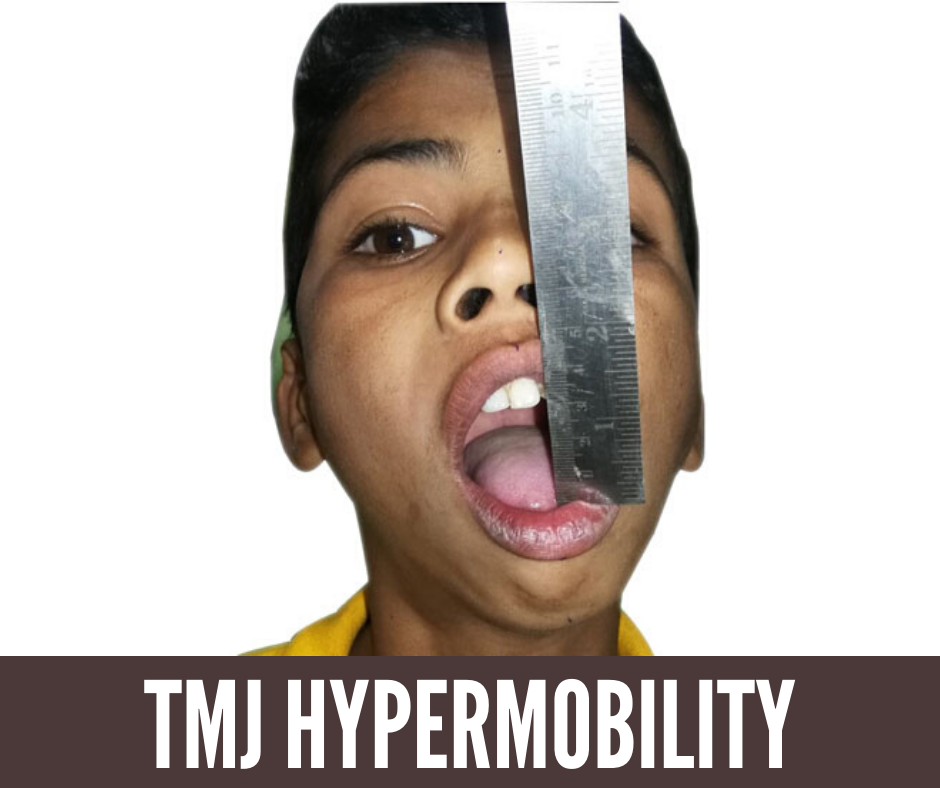Let’s first see what exactly is TMJ hypermobility as very few people know about it. Then, we will discuss its causes and characteristics.
What is TMJ Hypermobility?
Hypermobility is shown by early and greater forward gliding of one or both TMJs. This forward gliding causes the laxity of the capsule and ligaments and the temporalis tendon. The overstretching of these structures with the time can cause disk displacement/derangement to occur in single or both jaw joints or temporalis tendinitis. But, pain, functional loss, and mostly arthritic changes can set in. In extreme cases, the jaw can dislocate from its position and stay open, called an open lock.
The optimum range of jaw opening is 40 and 50 mm. The first 25 mm is mainly through the rotation which arises in the bottom half of joints in between the underneath surface of the disk and mandibular condyle of the jaw bone. The left 15 to 25 mm is achieved mainly through the forward gliding motion that arises in the middle of the temporal bone of the skull and the upper surface of the disk. Most patients suffering from TMJ hypermobility open more than 50 mm and could feel an eminence click.
For confirming that you suffer from TMJ hypermobility, we have some questions for you. If the answer to any of these questions is yes, you probably suffer from it.
- Q.1 In your childhood or teenage did your knee cap or shoulder dislocate during one or more than one time?
- Q.2 Can you bend your thumb to touch your forearm?
- Q.3 Do you believe that you are double-jointed?
- Q.4 Can you place your hands completely on the floor without folding your knees?
- Q.5 In your childhood, did you made weird shapes by bending your body in a different way other than normal twisting and bending?
If the answer to any of the two questions is yes, then it is a strong sign that you are suffering from TMJ hypermobility with greater accuracy.
Causes of TMJ Hypermobility
1. Natural Reasons:
- Yawning or Vomiting
- Wide biting or seizure disorder
2. External Reasons:
2.1 Injuries:
- Endoscopy
- Unnecessary hyperextensions
- Flexion, extension injury to the mandible
3. Miscellaneous Reasons:
- Occlusal discrepancies
- Internal derangement
- Host vertical dimensions
Clinical Characteristics of Hypermobility
Subluxation is identified by the mandible joining/ catching which is open for small period before it decreases itself into the shallow depression.
When the internal derangement is combined with hypermobility, higher number of clicks can be experienced that indicate the condyle breakage (sudden and complete) over the posterior and anterior edges of the disk.
Click arises only on wide opening and not on protrusive or lateral movement /excursions.
Diagnosing TMJ Hypermobility
To confirm TMJ hypermobility, doctors perform a physical examination and review your medical history. They may also use imaging techniques such as MRI or CT scans to view joint structures in detail. Some common diagnostic steps include:
- Range of Motion Tests: Evaluates jaw movement to determine if it exceeds the normal range.
- Joint Noise Examination: Listens for clicking or popping sounds associated with TMJ hypermobility.
- Stress Tests: Assesses how the jaw reacts under pressure to identify joint laxity or dislocation risks.
Treatment Options for TMJ Hypermobility
Treatment typically depends on the severity of symptoms. Here are some standard approaches:
Non-Surgical Treatments: For most patients, non-surgical treatments can help alleviate discomfort. This includes:
- Physical Therapy: Specific exercises to strengthen jaw muscles and improve stability.
- Jaw Stabilization Appliances: Special splints or mouth guards can prevent excessive jaw opening.
- Pain Management: Anti-inflammatory medications or corticosteroid injections can relieve pain and reduce inflammation.
Surgical Interventions: In severe cases, surgery might be recommended to correct joint structure or reposition the jaw.
- Arthrocentesis: A minimally invasive procedure where fluid is injected into the joint to reduce pain and inflammation.
- Disc Replacement or Repositioning: This may be needed when the disc is dislocated or damaged.
Self-Care Tips for TMJ Hypermobility
Managing TMJ hypermobility at home can help prevent discomfort and further issues:
- Avoid Wide Jaw Movements: Minimize yawning, loud chewing, or other activities that overextend the jaw.
- Practice Relaxation Techniques: Jaw tension is often worsened by stress, so meditation or deep breathing exercises can help.
- Apply Warm Compresses: Gentle heat therapy relaxes the muscles and reduces pain.
- Stay Mindful of Your Posture: Good neck and head posture can reduce pressure on the TMJ.
Lifestyle Adjustments for TMJ Health
- Dietary Modifications: Soft foods reduce strain on the jaw, especially during flare-ups.
- Sleep Positions: Sleeping on your back with proper support can ease stress on the jaw.
- Regular Exercise: Low-impact exercises like yoga help maintain flexibility and reduce tension.
If you are experiencing any symptoms related to TMJ hypermobility mentioned above, don't worry, Dr. Anurag Bhargava is here for you with the best TMJ treatment in India.


Excellent write-up. I certainly appreciate this site. Thanks! Delores Tris Ellerd
As a web site owner I believe the material here is reallyfantastic. I thank you for your time. You should keep it up forever! Best of luck.. Jaquelin Rafferty Golter
It is in point of fact a great and helpful piece of info. I am happy that you just shared this helpful information with us. Please stay us informed like this. Thanks for sharing. Suzette Yorgo Worsham